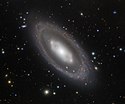NGC 7020
| Galaxie NGC 7020 / NGC 7021 | |
|---|---|
 | |
| Aufgenommen mit dem südlichen Teleskop des Gemini-Observatoriums | |
| AladinLite | |
| Sternbild | Pfau |
| Position Äquinoktium: J2000.0, Epoche: J2000.0 | |
| Rektaszension | 21h 11m 20,1s[1] |
| Deklination | -64° 01′ 31″[1] |
| Erscheinungsbild | |
| Morphologischer Typ | (R)SA(r)0^+[1][2] |
| Helligkeit (visuell) | 11,8 mag[2] |
| Helligkeit (B-Band) | 12,8 mag[2] |
| Winkelausdehnung | 3,5' × 1,6'[2] |
| Positionswinkel | 165°[2] |
| Flächenhelligkeit | 13,8 mag/arcmin²[2] |
| Physikalische Daten | |
| Zugehörigkeit | SSRS-Gruppe 8 IC 5096-Gruppe LGG 443[1][3] |
| Rotverschiebung | 0,010677 ± 0,000087[1] |
| Radialgeschwindigkeit | (3201 ± 26) km/s[1] |
| Hubbledistanz vrad / H0 | (139 ± 10) · 106 Lj (42,7 ± 3,0) Mpc [1] |
| Geschichte | |
| Entdeckung | John Herschel |
| Entdeckungsdatum | 31. August 1836 |
| Katalogbezeichnungen | |
| NGC 7020 • 7021 • PGC 66291 • ESO 107-013 • 2MASX J21112011-6401313 • SGC 210713-6413.8 • GALEXASC J211120.06-640130.1 • LDCE 1454 NED002 | |
NGC 7020 = NGC 7021 ist eine Elliptische Galaxie vom Hubble-Typ SB0 im Sternbild Pfau am Südsternhimmel. Sie ist schätzungsweise 139 Millionen Lichtjahre von der Milchstraße entfernt und hat einen Durchmesser von etwa 145.000 Lichtjahren. Gemeinsam mit IC 5096, IC 5084, IC 5092, PGC 66319 und PGC 66376 bildet sie die IC 5096-Gruppe oder LGG 443.
Im selben Himmelsareal befindet sich u. a. die Galaxie IC 5084.
Das Objekt wurde am 31. August 1836 vom britischen Astronomen John Herschel entdeckt.[4]
Weblinks
Einzelnachweise
Auf dieser Seite verwendete Medien
Autor/Urheber:
Credit: International Gemini Observatory/NOIRLab/NSF/AURA/H. Dottori, R. J. Díaz, G. Gimeno
Image processing: T.A. Rector (University of Alaska Anchorage/NSF’s NOIRLab), M. Zamani (NSF’s NOIRLab) & D. de Martin (NSF’s NOIRLab), Lizenz: CC BY 4.0A Hexagonal Galactic Center
NGC 7020, a barred lenticular galaxy in the southern constellation Pavo, holds a geometric mystery. Clear but subtle in this image from Gemini South, one half of the International Gemini Observatory, a Program of NSF’s NOIRLab, the core of NGC 7020 is visibly hexagonal in shape. A hexagon is not a common shape for any celestial body, let alone an entire galaxy. To form a hexagonal structure such as this, a considerable number of stars must orbit in a very narrow band. This orbital path includes two denser regions of stars seen on the left and right sides of the hexagon, which are known as “ansae”. NGC 7020’s unusual shape seems to be the product of a very rare orbital resonance, or an as-yet-unknown phenomenon.
The 8-meter Gemini South telescope is located on Cerro Pachón in the Chilean Andes. Along with the other half of the international Gemini observatory, Gemini North in Hawai‘i, these two telescopes give us a deep view of the entire night sky.
Credit: International Gemini Observatory/NOIRLab/NSF/AURA/H. Dottori, R. J. Díaz, G. Gimeno
Image processing: T.A. Rector (University of Alaska Anchorage/NSF’s NOIRLab), M. Zamani (NSF’s NOIRLab) & D. de Martin (NSF’s NOIRLab)
Position (RA): 21 11 19.85 Position (Dec): -64° 1' 32.54" Field of view: 5.44 x 4.53 arcminutes Orientation: North is 300.0° right of vertical
Colors & filters
Band Wave-length Tele-scope
Optical g 475 nm Gemini South GMOS-S
Optical r 630 nm Gemini South GMOS-S
Optical i 780 nm Gemini South GMOS-S
Optical H-alpha 656 nm Gemini South GMOS-S
